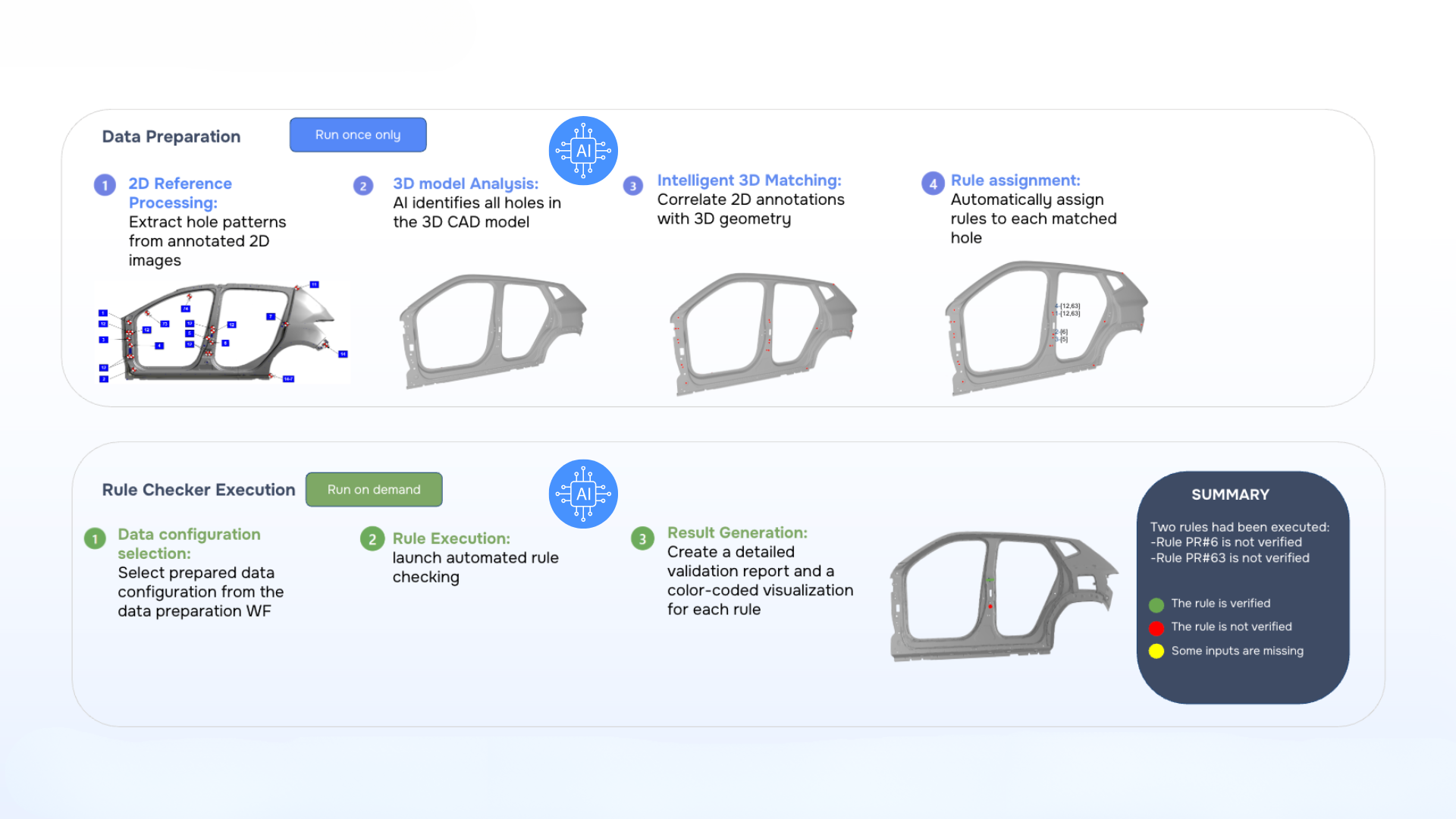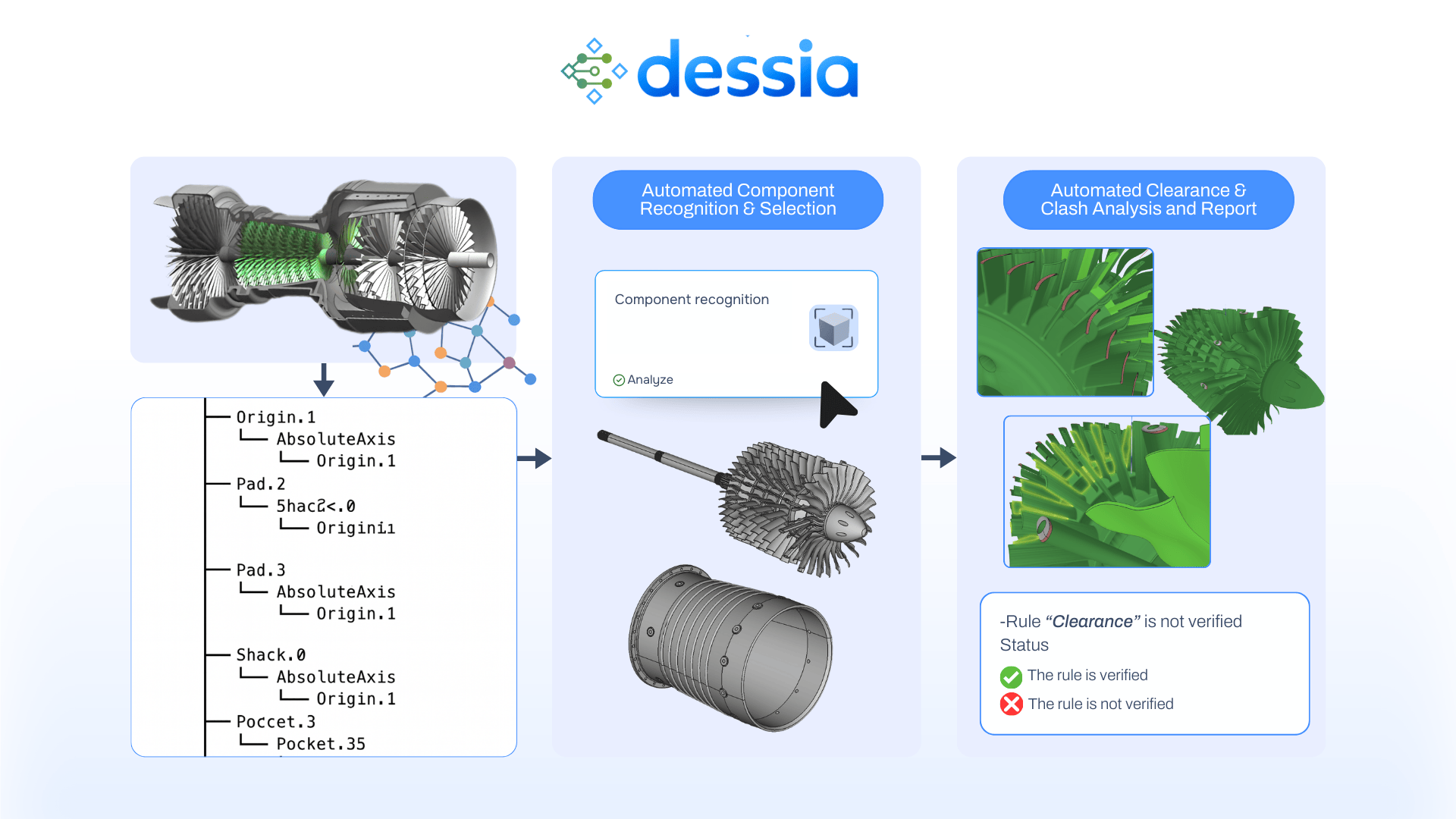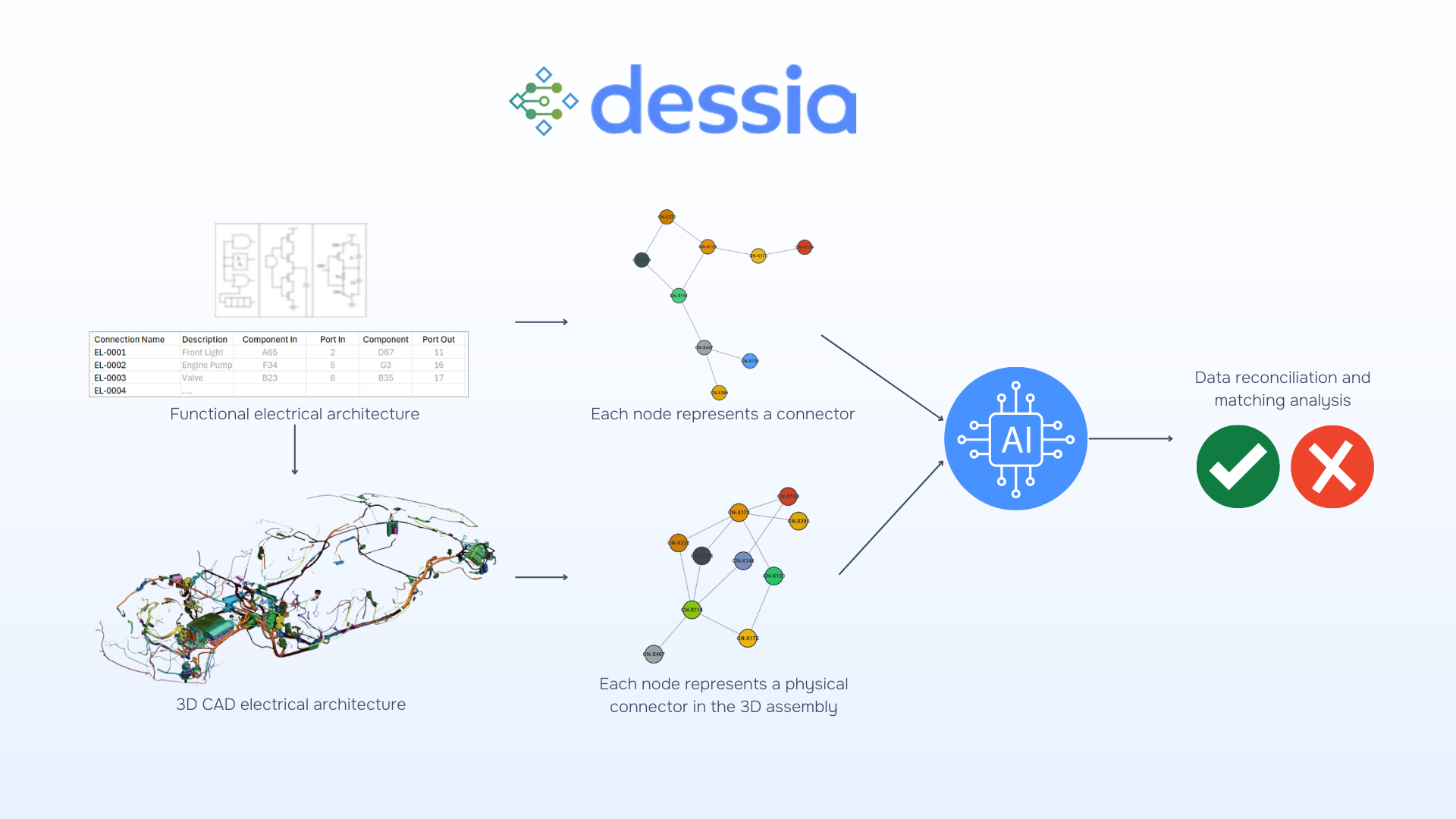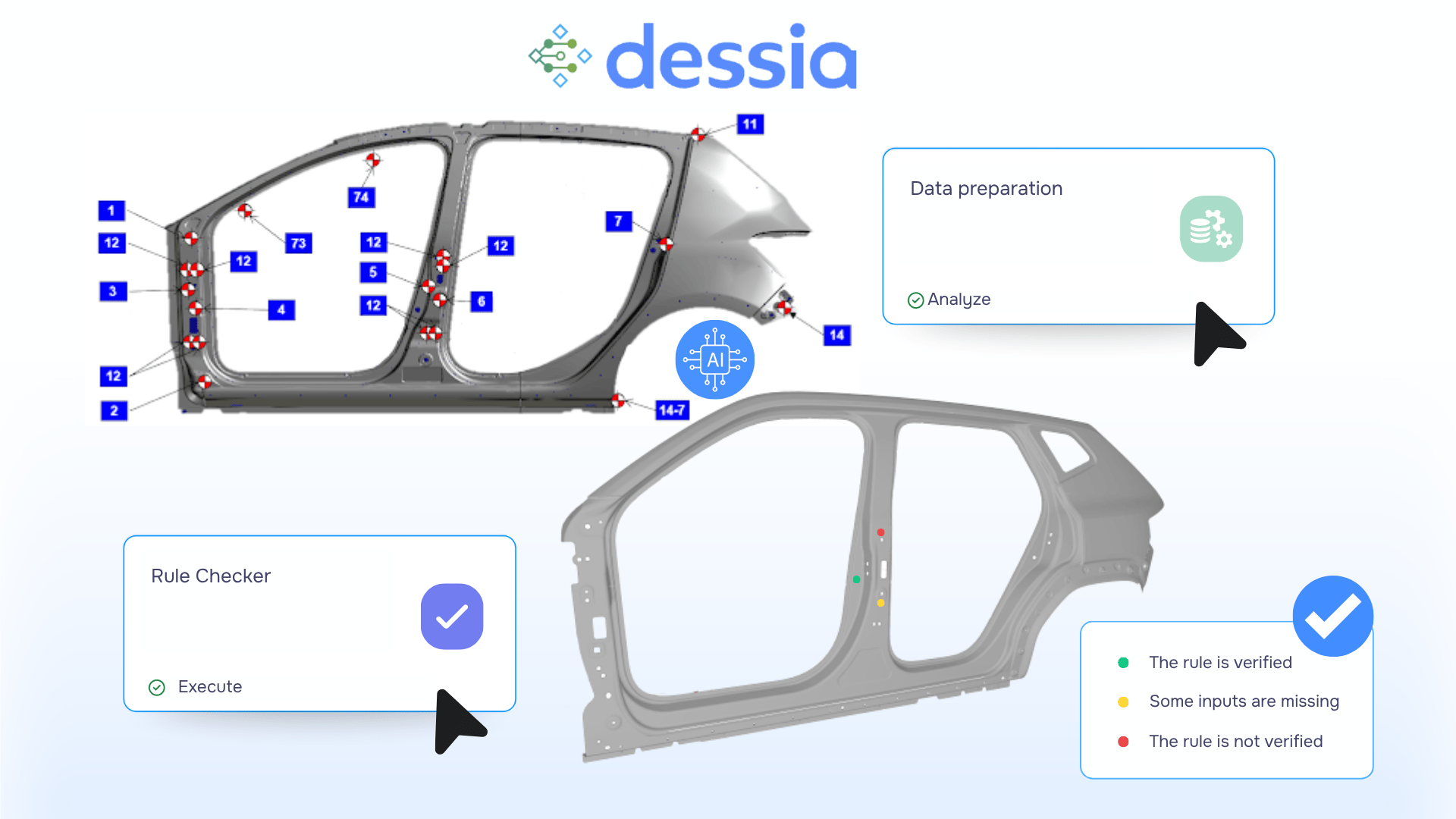AI Automates CAD rule checks for vehicle body validation
This case study shows how a design team automated complex rule validation directly on their 3D CAD models. With Dessia’s platform, they reduced verification time by 80% while ensuring full traceability, consistency, and scalability.
Introduction
Ensuring that engineering designs comply with process requirements (PRs) is a constant challenge in vehicle body structure development. From hole positioning for jigs to gauge surface validation, industrialization team must align with hundreds of internal rules, often buried in spreadsheets or manuals, and the checks are still largely manual.
This case study explores how Dessia’s AI-powered automation platform and libraries enabled an automotive design team to transform a rule-checking process that once took hours into an intelligent, traceable, and scalable system. By leveraging CAD analysis, knowledge graphs, and rule-aware agents, they achieved fast, reliable compliance checks directly from their 3D models.
The challenge : Manual rule checks, tribal knowledge, and the cost of inconsistency
When dealing with complex body side assemblies, even seemingly simple tasks, like verifying hole shapes or jig surface positioning, can involve layers of internal logic:
- What shape should the hole be for a given jig?
- Is it in the correct direction?
- Is it inside the positioning box?
- Are the gauges resting on a flat, rigid surface?
Each of these rules exists somewhere in a PDF, a PLM note, or someone's memory. But design teams often lack a structured, automated way to apply them consistently across part revisions or vehicle platforms.
Key pain points included:
- Manual CAD checks at each design milestone (slow and error-prone)
- Lack of traceability in who checked what, and when
- No guarantee of consistency across teams or programs
- Difficulty updating the rule set when process requirements evolved
The industrialization team needed a system that could apply complex, multi-step rules directly to 3D models — automatically and traceably.
The solution: An end-to-end rule validation workflow powered by AI
Dessia’s AI platform introduced an automated, knowledge-driven workflow that connects CAD inputs, rule logic, and validation outputs in a seamless pipeline.
Step 1: CAD data preparation
The system first ingests the CAD model and performs:
- Geometric analysis of the part
- Environment recognition (For ex. body side context)
- Pre-mapping of applicable rules via a knowledge graph
The knowledge graph is used to identify:
- Which process requirements are specified for this validation set
- Where exactly on the CAD model each rule should apply
Step 2: rule execution
Each applicable PR is run through the Workflow Rules Checker. The system performs detailed geometric and relational checks such as:
- Hole shape, dimensions, and accessibility
- Relative hole positioning (for ex. diagonal vs horizontal)
- Presence and orientation of required surfaces (for ex. flat zones near hinge holes)
Step 3: Result output
The output is a structured report, showing which rules passed and which failed, complete with:
- A color-coded 3D visualization (OK = green, NOK = red)
- A detailed table of parameters, dimensions, and PR references
This format enables both engineers and quality reviewers to quickly interpret results and take action.

Outcomes & impact : From manual reviews to real-time, scalable design compliance
Dessia’s platform enables design industrialization teams to scale process compliance checks while reducing manual effort, increasing robustness, and accelerating design convergence.
By automating validation directly on native CAD models, teams reduce verification time by over 80%, eliminate variability in rule interpretation, and ensure consistent enforcement of internal standards across programs and geographies. What previously required expert reviews, tribal knowledge, or post-milestone corrections is now embedded as an upstream design activity.
Beyond efficiency, the system reinforces traceability. Each checker execution produces a structured, timestamped log with CAD version, applied rules, and validation results, removing ambiguity during design reviews or quality audits
As organizations formalize their process requirements into executable logic, they establish a reusable and scalable rule foundation. These rules can be applied across product lines, adapted incrementally, and owned directly by engineering, without relying on custom scripts or external developers.
Ultimately, the platform transforms rule checking from a reactive quality control step into a proactive design asset.
Value proposition
Rule formalization
- Internal process rules are encoded as modular, versioned logic blocks
- Supports geometric, topological, relational, and conditional constraints
- Enables formal enforcement of engineering standards at scale
Native CAD execution
- Compatible with CATIA, Siemens NX, STEP, and other CAD Vendors fromats
- Operates directly on native 3D geometry, no conversion required
- Analyzes part, assembly, and environment-level contexts
Structured, interoperable outputs
- Generates machine-readable reports: rule IDs, pass/fail status, geometric parameters, object references
- Outputs can be exported to PLM, QMS, or digital continuity tools
- Enables traceable compliance workflows from design to certification
Modular & evolutive architecture
- Checkers are built as independent, reusable applications
- Logic can be updated or extended without affecting existing workflows
- Scalable across vehicle platforms, engineering departments, and industrial sites
Seamless integration
- Can be triggered manually, in batch, or as part of automated validation pipelines
- Does not require modification of existing CAD or PLM toolchains
- API and UI-based options for deployment across engineering teams
Conclusion
The integration of formalized rule validation into design workflows is no longer a competitive advantage, it is a structural necessity. As engineering teams operate across distributed platforms, evolving product lines, and stringent process requirements, the capacity to enforce design logic consistently and at scale becomes foundational to both operational integrity and product quality.
Dessia’s solution addresses this imperative not by layering another verification tool into the stack, but by embedding intelligence directly within engineering decision cycles. Its architecture supports the abstraction of institutional knowledge into scalable logic objects that persist across revisions, programs, and teams. This enables organizations to transition from reactive inspection models to proactive compliance by design.
Importantly, the platform shifts the focus of engineering governance: from post-validation control to real-time technical alignment. Design intent, process constraints, and production feasibility are no longer managed in parallel, they are unified through executable logic operating at the core of the CAD environment.
As organizations seek to industrialize knowledge, shorten iteration loops, and safeguard against quality drift, Dessia offers a framework not just for automation, but for structured engineering evolution. It lays the groundwork for a more resilient, traceable, and technically coherent design ecosystem, capable of scaling without compromise.
Keep exploring - Discover more case studies

AI Verification & Validation
9
min reading


AI Verification & Validation
8
min reading

